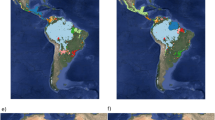Abstract
We consider a forest-fire model which, somewhat informally, is described as follows: Each site (vertex) of the square lattice is either vacant or occupied by a tree. Vacant sites become occupied at rate 1. Further, each site is hit by lightning at rate λ. This lightning instantaneously destroys (makes vacant) the occupied cluster of the site.
This model is closely related to the Drossel-Schwabl forest-fire model, which has received much attention in the physics literature. The most interesting behaviour seems to occur when the lightning rate goes to zero. In the physics literature it is believed that then the system has so-called self-organized critical behaviour.
We let the system start with all sites vacant and study, for positive but small λ, the behaviour near the ‘critical time’ t c , defined by the relation 1 − exp(− t c ) = p c , the critical probability for site percolation.
Intuitively one might expect that if, for fixed t > t c , we let simultaneously λ tend to 0 and m to ∞, the probability that some tree at distance smaller than m from O is burnt before time t goes to 1. However, we show that under a percolation-like assumption (which we can not prove but believe to be true) this intuition is false. We compare with the case where the square lattice is replaced by the directed binary tree, and pose some natural open problems.
Similar content being viewed by others
References
van den Berg J., Járai A.A. (2004) On the asymptotic density in a one-dimensional self-organized critical forest-fire model. Commun. Math. Phys. 253, 633–644
van den Berg, J., Brouwer, R. Self-destructive percolation. Random Structures and Algorithms 24, Issue 4, 480–501 (2004)
Drossel B., Schwabl F. (1992) Self-organized critical forest-fire model. Phys. Rev. Lett. 69, 1629–1632
Dürre, M. Existence of multi-dimensional infinite volume self-organized critical forest-fire models. Preprint (2005)
Grassberger P. (2002) Critical behaviour of the Drossel-Schwabl forest fire model. New J. Phys. 4, 17.1–17.15
Grimmett G.R. (1999) Percolation. Springer-Verlag, Berlin-Heidelberg-New York
Jensen H.J. (1998) Self-Organized Criticality, Cambridge Lecture Notes in Physics, Cambridge Univ. Press, Cambridge
Malamud B.D., Morein G., Turcotte D.L. (1998) Forest Fires: An example of self-organized critical behaviour. Science 281, 1840–1841
Schenk K., Drossel B., Schwabl F. Self-organised critical forest-fire model on large scales. Phys. Revi. E 65, 026135-1-8 (2002)
Author information
Authors and Affiliations
Corresponding author
Additional information
Communicated by H. Spohn
Part of vdB’s research is supported by BRICKS project AFM 2.2.
Rights and permissions
About this article
Cite this article
van den Berg, J., Brouwer, R. Self-Organized Forest-Fires Near the Critical Time. Commun. Math. Phys. 267, 265–277 (2006). https://doi.org/10.1007/s00220-006-0025-1
Received:
Accepted:
Published:
Issue Date:
DOI: https://doi.org/10.1007/s00220-006-0025-1




